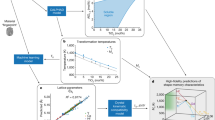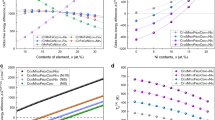Abstract
Reversibility of structural phase transformations has profound technological implications in a wide range of applications from fatigue life in shape-memory alloys (SMAs) to magnetism in multiferroic oxides. The geometric nonlinear theory of martensite universally applicable to all structural transitions has been developed. It predicts the reversibility of the transitions as manifested in the hysteresis behaviour based solely on crystal symmetry and geometric compatibilities between phases. In this article, we report on the verification of the theory using the high-throughput approach. The thin-film composition-spread technique was devised to rapidly map the lattice parameters and the thermal hysteresis of ternary alloy systems. A clear relationship between the hysteresis and the middle eigenvalue of the transformation stretch tensor as predicted by the theory was observed for the first time. We have also identified a new composition region of titanium-rich SMAs with potential for improved control of SMA properties.
This is a preview of subscription content, access via your institution
Access options
Subscribe to this journal
Receive 12 print issues and online access
$259.00 per year
only $21.58 per issue
Buy this article
- Purchase on Springer Link
- Instant access to full article PDF
Prices may be subject to local taxes which are calculated during checkout




Similar content being viewed by others
References
Allie, D. E., Hebert, C. J. & Walker, C. M. Nitinol stent fractures in the SFA. Endovasc. Today 7, 22–34 (2004).
Bhattacharya, K., Conti, S., Zanzotto, G. & Zimmer, J. Crystal symmetry and the reversibility of martensitic transformations. Nature 428, 55–59 (2004).
Bhattacharya, K. & James, R. D. The material is the machine. Science 307, 53–54 (2005).
Ball, J. M. & James, R. D. Proposed experimental tests of a theory of fine microstructure and the two well problem. Phil. Trans. R. Soc. Lond. A 338, 389–450 (1992).
James, R. D. & Zhang, Z. in Magnetism and Structure in Functional Materials (eds Mañosa, L., Planes, A. & Saxena, A.) (Springer Series in Materials Science, Vol. 79, Springer, New York, 2005).
Kato, H., Ozu, T., Hashimoto, S. & Miura, S. Cyclic stress–strain response of superelastic Cu-Al-Mn alloy single crystals. Mater. Sci. Eng. A 264, 245–253 (1999).
Miyazaki, S. & Ishida, A. Martensitic transformation and shape memory behavior in sputterdeposited TiNi-base thin films. Mater. Sci. Eng. A 273–275, 106–133 (1999).
Nam, T. H., Saburi, T. & Shimizu, K. Cu-content dependence of shape memory characteristics in Ti-Ni-Cu alloys. Mater. Trans. JIM 31, 959–967 (1990).
Hashinaga, T., Miyazaki, S., Ueki, T. & Horikawa, H. Transformation and deformation behavior in sputter-deposited Ti-Ni-Cu thin films. J. Phys. IV 5, C8 689–C8 694 (1995).
Miyazaki, S., Hashinaga, T. & Ishida, A. Martensitic transformations in sputter-deposited Ti-Ni-Cu shape memory alloy thin films. Thin Solid Films 281–282, 364–367 (1996).
Fukuda, T., Saburi, T., Chihara, T. & Tsuzuki, Y. Mechanism of B2-B19-B19′ transformation in shape memory Ti–Ni–Cu alloys. Mater. Trans. JIM 36, 1244–1255 (1995).
Bricknell, R. H., Melton, K. N. & Mercier, O. The structure of NiTiCu shape memory alloys. Metall. Trans. A. 10, 693–699 (1979).
Tang, W., Sandstrom, R., Wei, Z. G. & Miyazaki, S. Experimental investigation and thermodynamic calculation of the Ti-Ni-Cu shape memory alloys. Metall. Mater. Trans. A 31, 2423–2430 (2000).
Takeuchi, I. et al. Identification of novel compositions of ferromagnetic shape memory alloys using composition spreads. Nature Mater. 2, 180–184 (2003).
Faulkner, M. G., Amalra, J. J. & Bhattacharyya, A. Experimental determination of thermal and electrical properties of NiTi shape memory wires. Smart Mater. Struct. 9, 632–639 (2000).
Acknowledgements
This work was supported by ONR-N000140110761, ONR-N000140410085, NSF DMR-0231291, NSF DMS-0074043 and MRSEC DMR-0520471. Use of the Advanced Photon Source was supported by the US Department of Energy, Office of Science, Office of Basic Energy Sciences, under Contract No W-31-109-Eng-38.
Author information
Authors and Affiliations
Corresponding author
Ethics declarations
Competing interests
The authors declare no competing financial interests.
Rights and permissions
About this article
Cite this article
Cui, J., Chu, Y., Famodu, O. et al. Combinatorial search of thermoelastic shape-memory alloys with extremely small hysteresis width. Nature Mater 5, 286–290 (2006). https://doi.org/10.1038/nmat1593
Received:
Accepted:
Published:
Issue Date:
DOI: https://doi.org/10.1038/nmat1593
This article is cited by
-
Combinatorial Alloy Design: Renaissance in the Accelerated Development of High-Entropy Alloys
Transactions of the Indian National Academy of Engineering (2024)
-
First-principles calculations of Ni-(Co)-Mn-Cu-Ti all-d-metal Heusler alloy on martensitic transformation, mechanical and magnetic properties
International Journal of Minerals, Metallurgy and Materials (2023)
-
Geometry of Needle-Like Microstructures in Shape-Memory Alloys
Shape Memory and Superelasticity (2023)
-
Enhancing Shape Memory Response of Additively Manufactured Niti Shape Memory Alloys by Texturing and Post-Processing Heat Treatment
Shape Memory and Superelasticity (2023)
-
Thin-Film Superelastic Alloys for Stretchable Electronics
Shape Memory and Superelasticity (2023)



